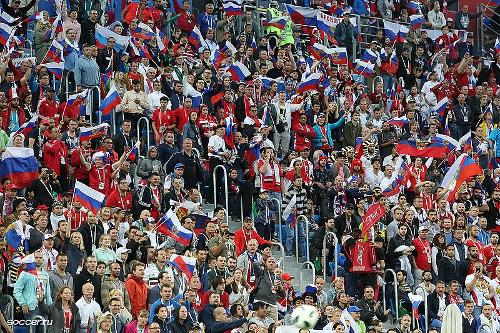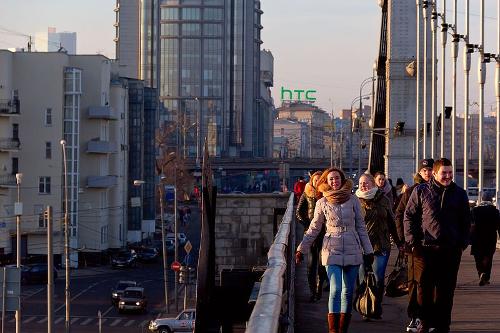RUSSIA
Population

Population
Cities in RUSSIA
| Moscow | Saint-petersburg |
Population
General
 Russian Football fansPhoto: Unkown CC 3.0 Unported no changes
Russian Football fansPhoto: Unkown CC 3.0 Unported no changes
Approx. 77.7% of Russia's total population consists of Russians (2024). There are also about a hundred smaller peoples scattered across the vast country, of which the largest and best known are the Tatars (3.7%) and the Ukrainians (1.4%). Finno-Ugric peoples live in the northeast of the European part, in the Volga-Kama area and further east. The Mongols live near Lake Baikal and the Caspian Sea, and the Tungus live in the area between Yenisei and Lena, between Lena and the Sea of Okhotsk and in the basin of the Indigirka.
Of the northern peoples are the Nenets (35,000) from the Arkhangelsk region are the most numerous, followed by the Evenki (30,000) from the Krasnoyarsk region, the Eveni (17,000) from the Enisoy and the Chukchen (15,000) from the north of Kamchatka.
Van the Dolgans on the Tajmyr peninsula there are less than 7,000 left and other groups are even smaller: the Nganasans of Tajmyr (1300), the Jenets of the Lower Enisej (200), the Yukaghir of Kolyma (1100), the Inuit of the Bering Strait (1700), the Aleutian Islands of Kamchatka (700) and the Nivkhs (4600) and Oroks (700) of Sakhalin.
Spread
 People walking in Moscow, RussiaPhoto: Pawel Maryanov CC 2.0 Generic no changes made
People walking in Moscow, RussiaPhoto: Pawel Maryanov CC 2.0 Generic no changes made
Most of the population lives in the European part of Russia; the most sparsely populated are the parts of the country east of the Urals and the north of European Russia. The center, located around Moscow, has the highest total population density.
75.3% of the population lives in an urban area, but this percentage varies greatly by region: in Central Russia no less than 83% of the population lives in cities, in the North Caucasus it is only 57%. The main two cities are Moscow (10.5 million inhabitants) agglomeration: 12.7 million) and Saint-petersburg (5.6 million inhabitants).
There are more than 8 people per km2 in Russia, which makes Russia, of the largest countries after Canada, the country with the lowest population density.
Demographics
In 2024, there were 141 million inhabitants in Russia. The economic and social changes in the 1990s resulted in negative demographic developments. The population is aging due to a falling birth rate (in 2024: 8.4 per 1000 inhabitants) and an increasing death rate (in 2024: 14 per 1000 inhabitants).
The deteriorating socio-medical conditions (including alcohol and drug use) are reflected in the relatively low average life expectancy, especially for men: 67.4 years for men and 77.4 years for women in 2024. Russians returning from other former Soviet republics in the 1990s provided a balance for some time, but by 2004 the immigration balance had fallen to 1.02% per 1000 inhabitants. They mainly left the crisis areas of neighboring countries such as Tajikistan, Georgia and Azerbaijan.
Age structure population
0-14 years 16.5%
15-64 years 65.7%
65+ 17.8 %
Sources
Graaf, A. van der / Reis-handboek Sovjet-Unie
Elmar
Rusland, Centraal-Azië en de Kaukasus
The Reader’s Digest,
Russia & Belarus
Lonely Planet
Te gast in Rusland
Informatie Verre Reizen
CIA - World Factbook
BBC - Country Profiles
Copyright: Team The World of Info